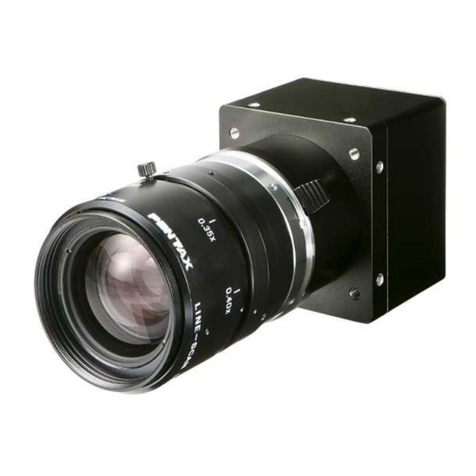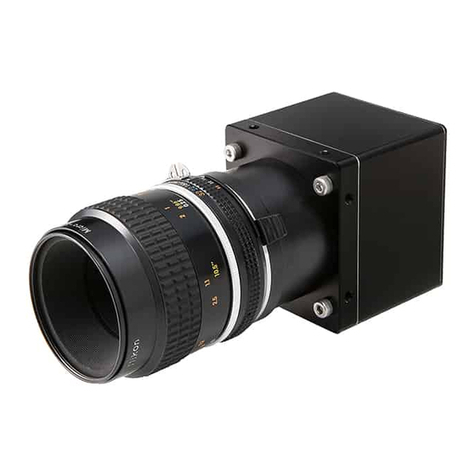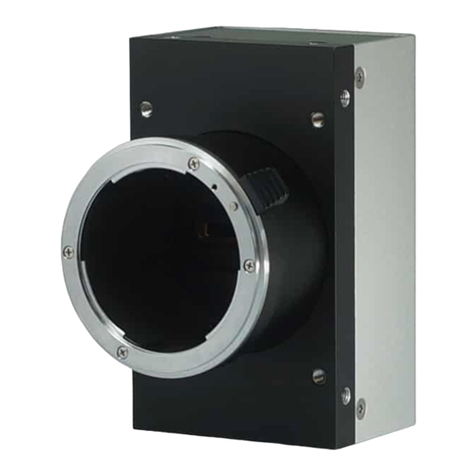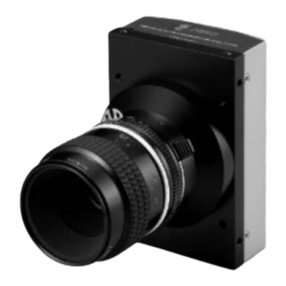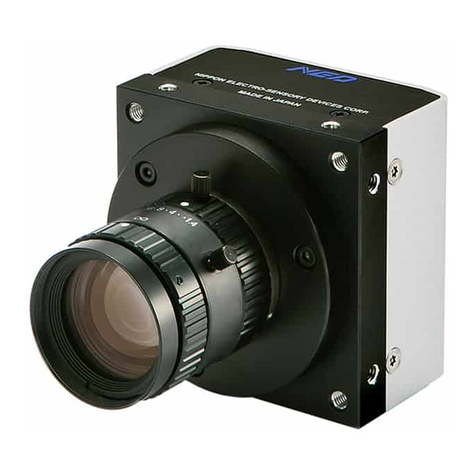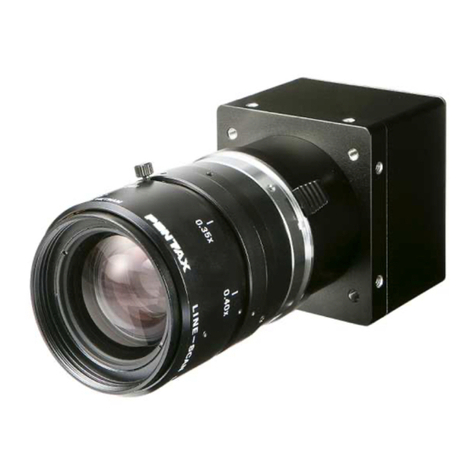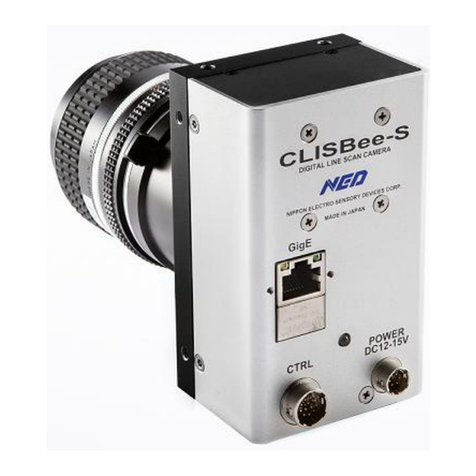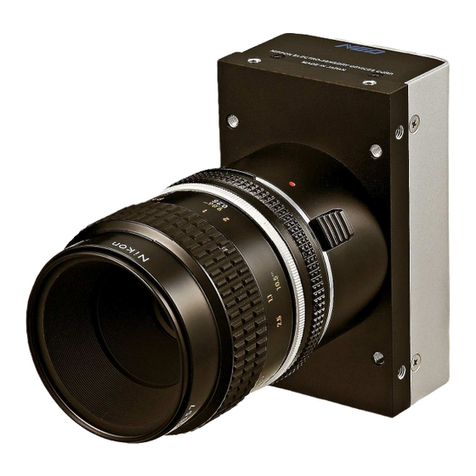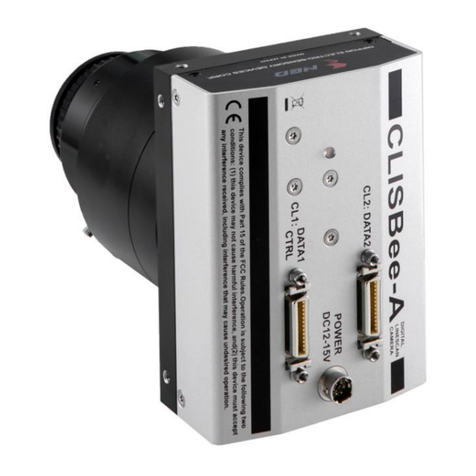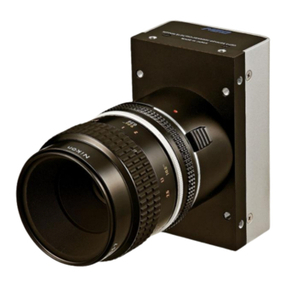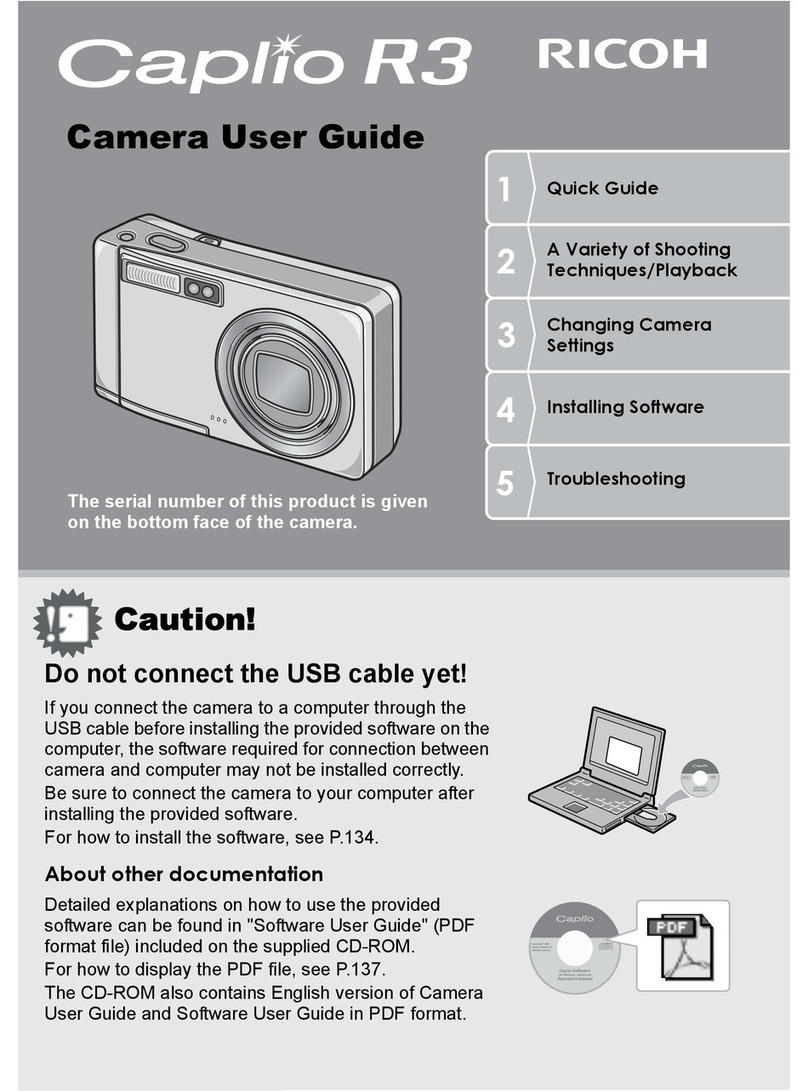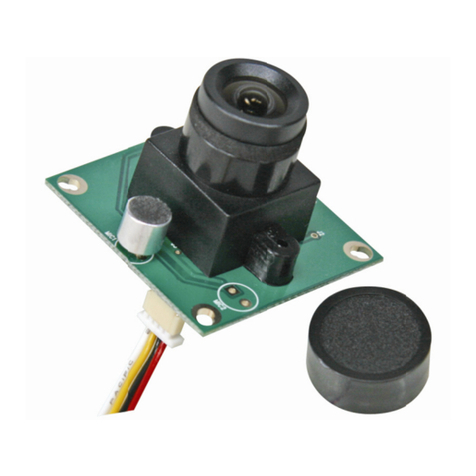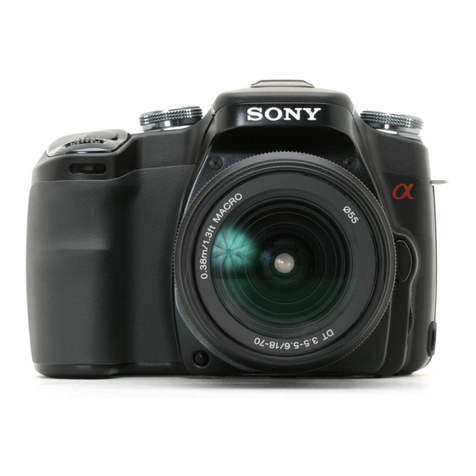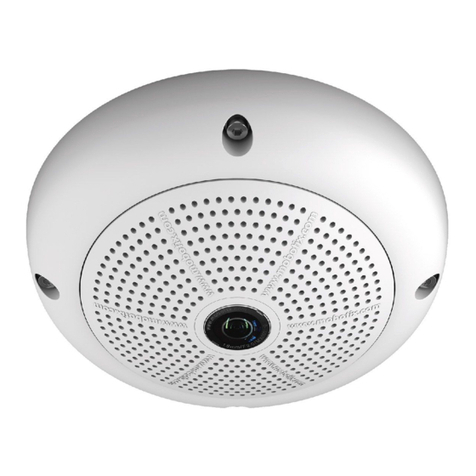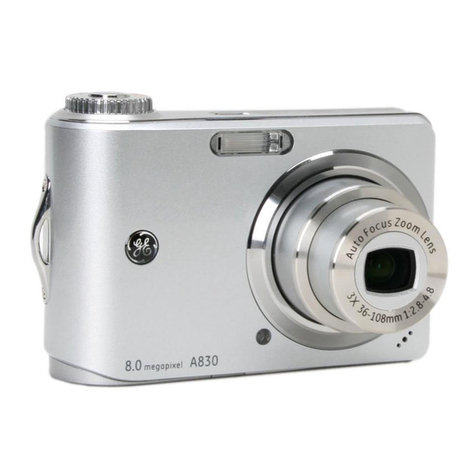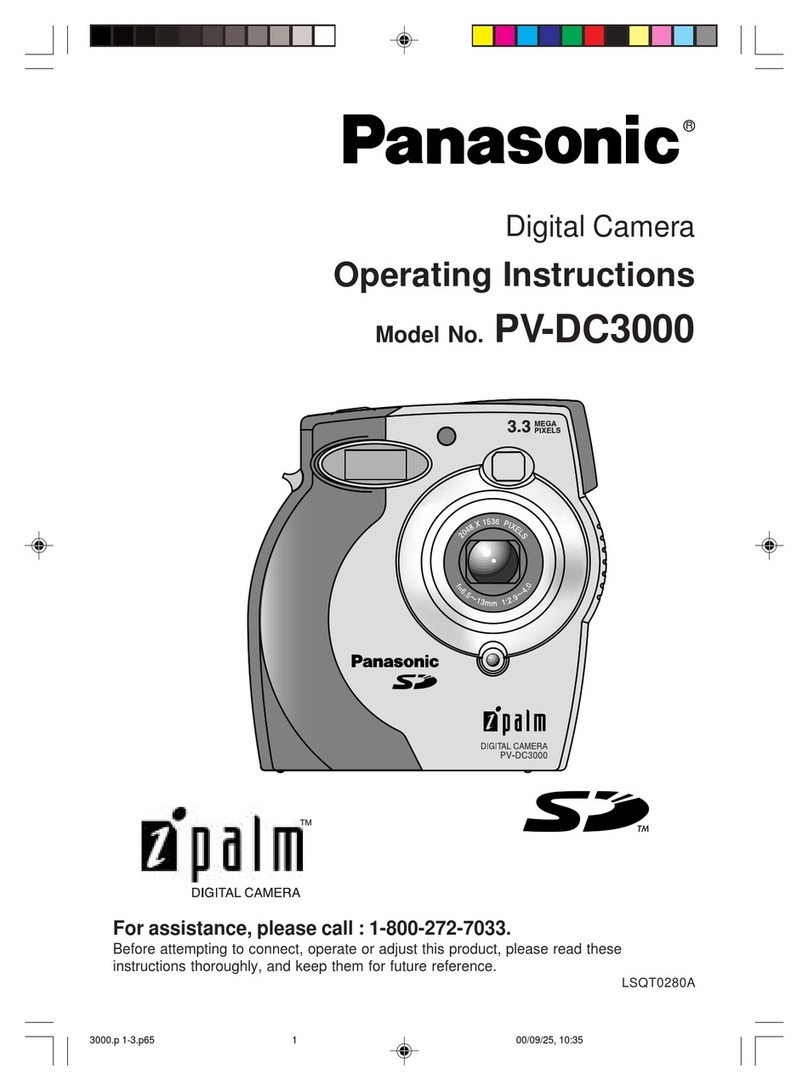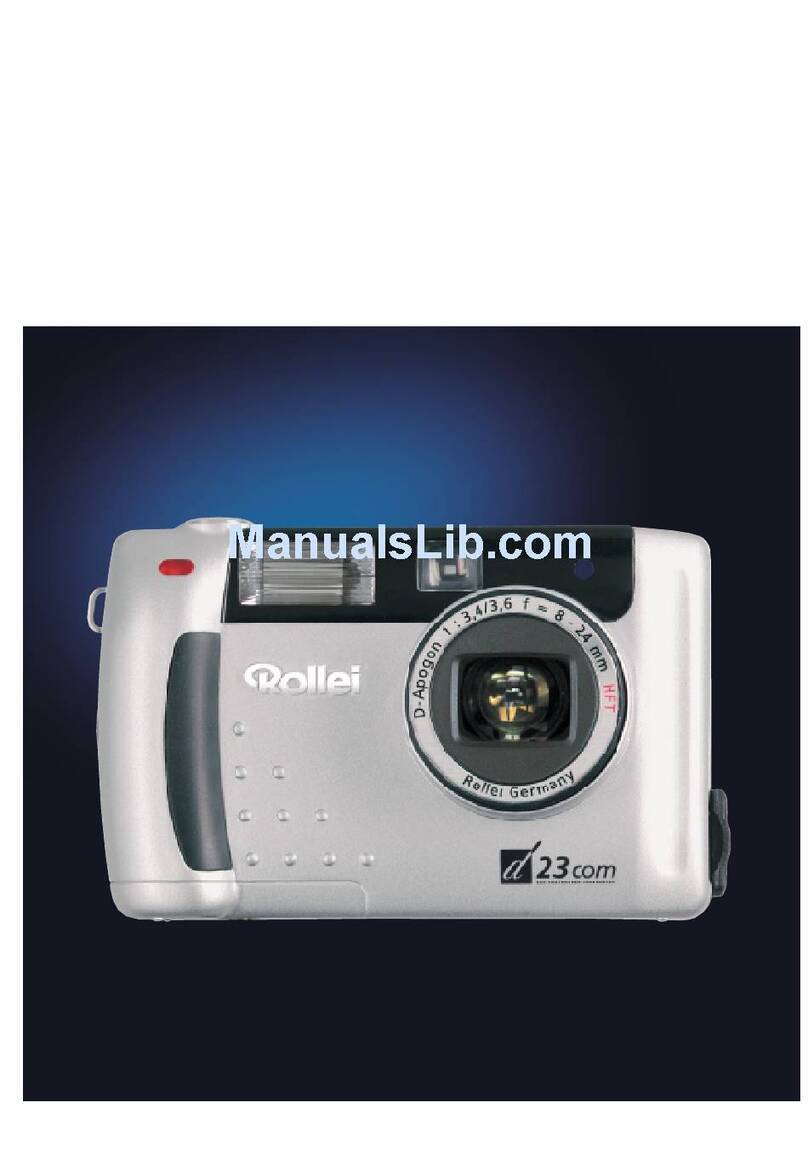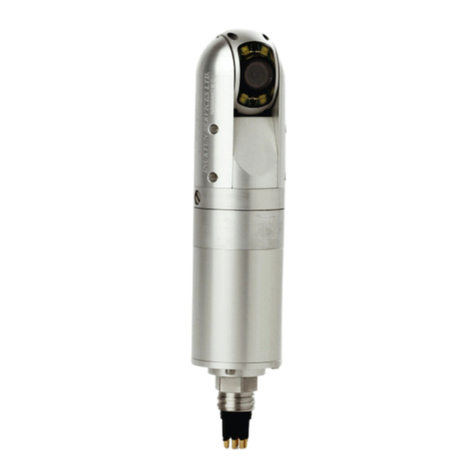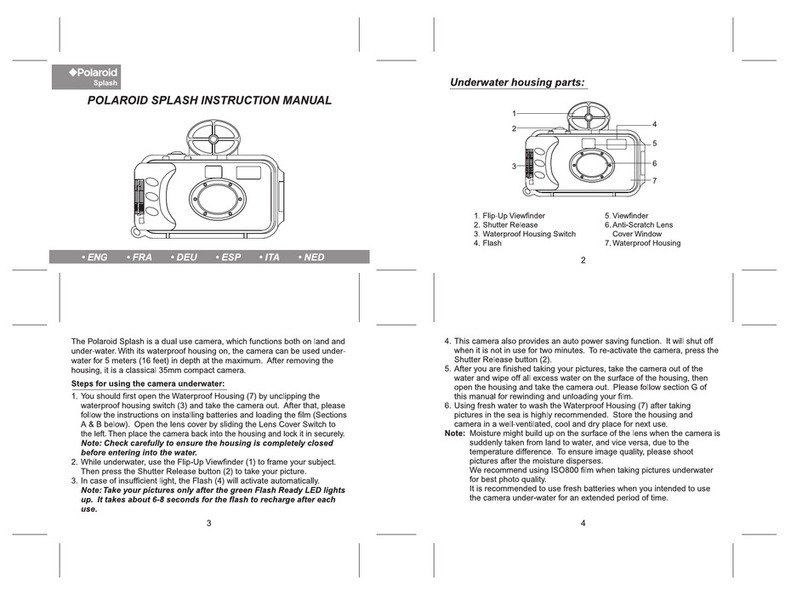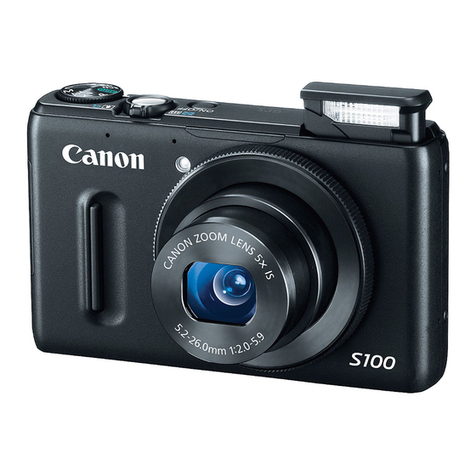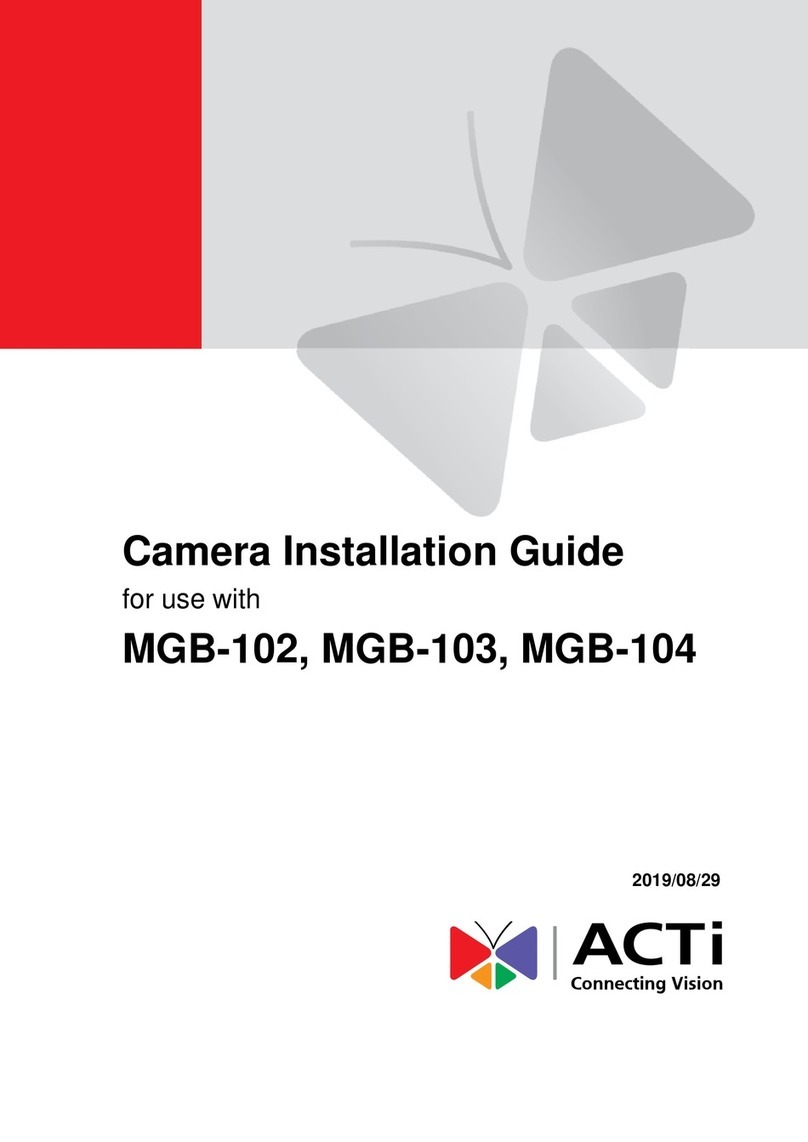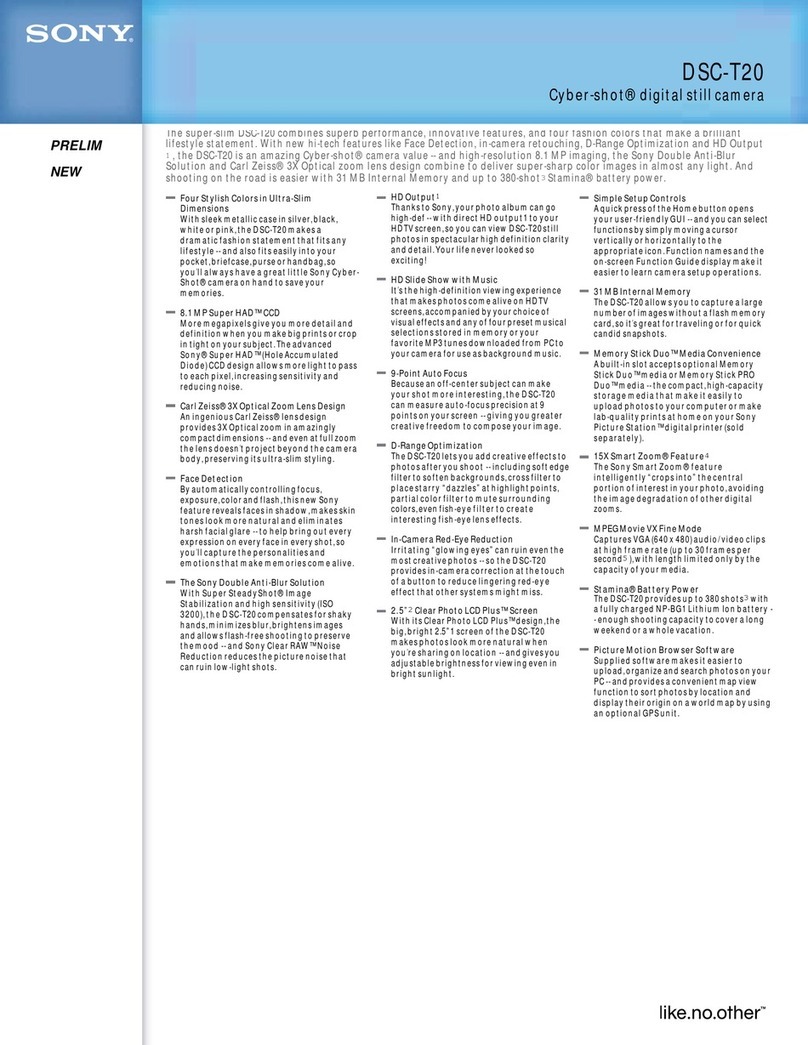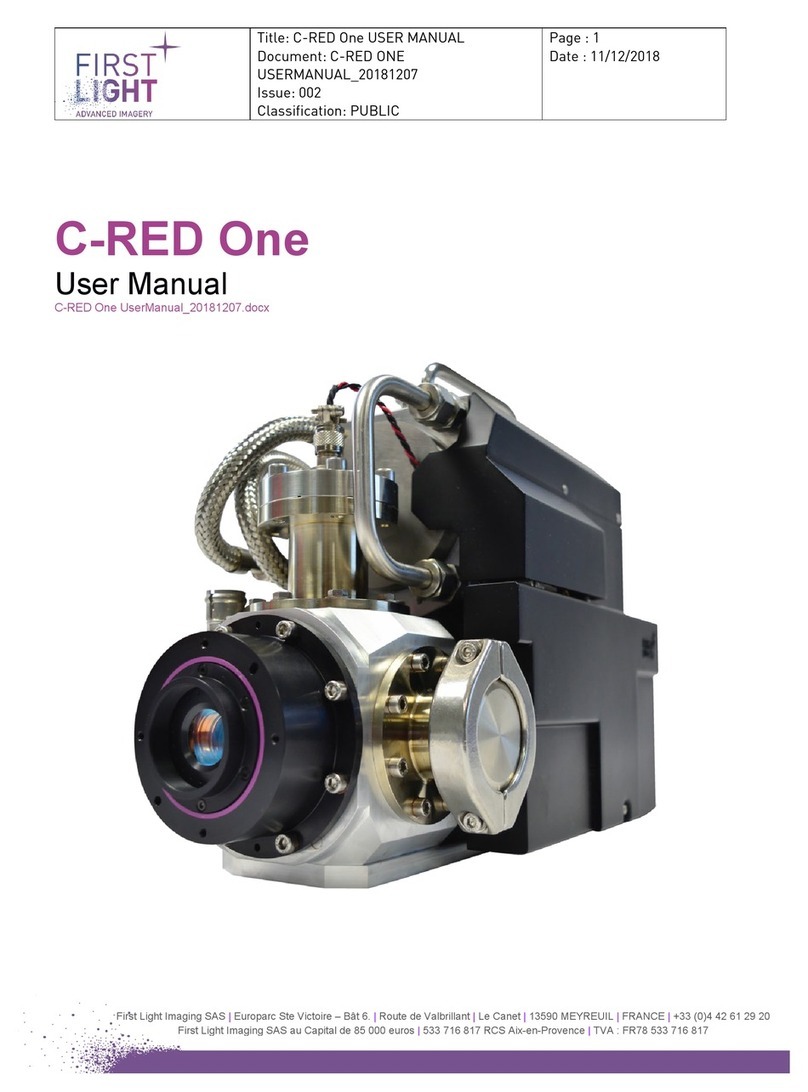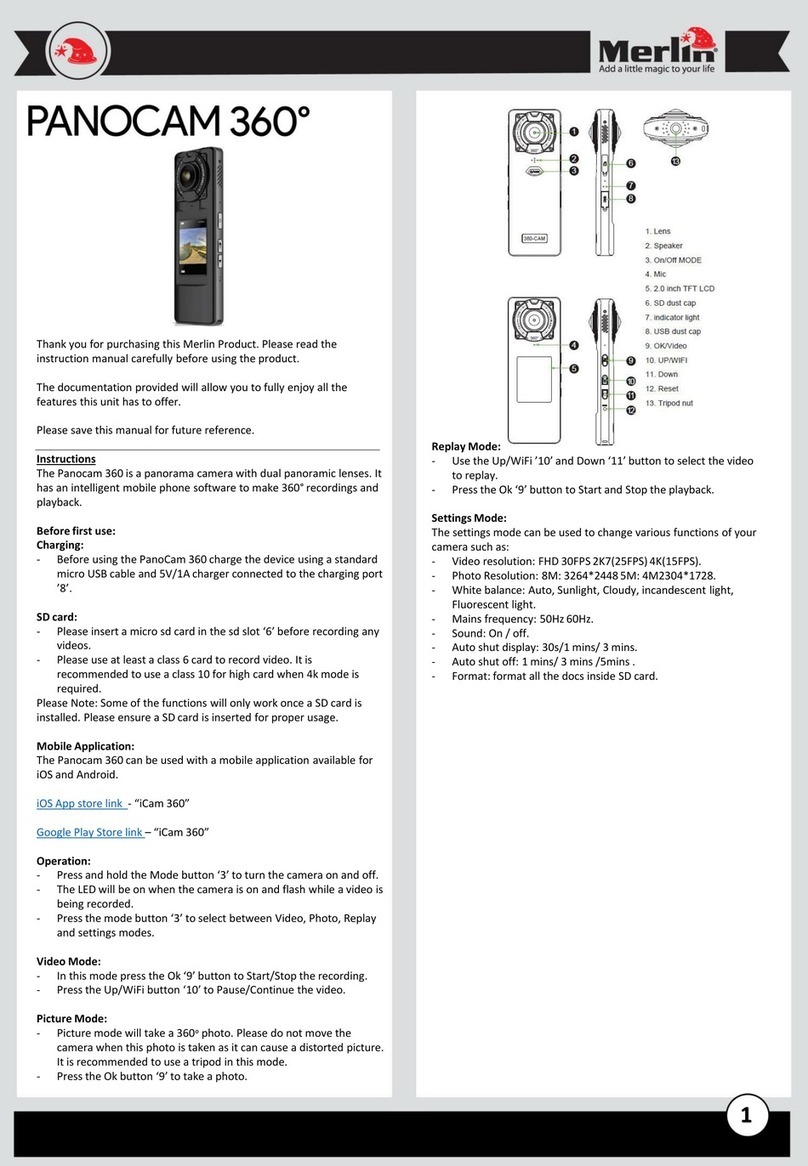NED CAMERA Link Ryugan RCDL2K20CL User manual

User’s Manual
Line Scan Camera
Type: RCDL2K20CL
NIPPON ELECTRO-SENSORY DEVICES CORPORATION

2NED
RCDL2K20CL UME-0115-02
For Customers in the U.S.A.
This equipment has been tested and found to comply with the limits for a Class A
digital device, in accordance with Part 15 of the FCC Rules. These limits are designed to
provide reasonable protection against harmful interference when the equipment is
operated in a commercial environment. This equipment generates, uses, and can
radiate radio frequency energy and, if not installed and used in accordance with the
instruction manual, may cause harmful interference to radio communications. Operation
of this equipment in a residential area is likely to cause harmful interference, in which
case the user will be required to correct the interference at his or her own expense.
For Customers in the EU
This equipment has been tested and found to comply with the essential requirements
of the EMC Directive 2004/108/EC, based on the following specifications applied:
EU Harmonised Standards
EN55032:2015 Class A
EN55011:2009+A1:2010 Class A
EN61000-6-2:2005
Directive on Waste Electrical and Electronic Equipment (WEEE)
Please return all End of Life NED products to the distributor from whom the product
was purchased for adequate recycling and / or disposal. All costs of returning the
Product to NED are borne by the shipper.

3NED
RCDL2K20CL UME-0115-02
Introduction
Thank you for purchasing NED’s Line Scan Camera. We look forward to your
continued custom in the future.
For safety use
◆For your protection, please read these safety instructions completely before
operating the product and keep this manual for future reference.
◆The following symbols appear next to important information regarding safe product
handling.
Warning
If the product is not handled properly, this may result
in serious injury or possible death.
Caution
If the product is not handled properly, this may result
in physical injury or cause property damage.
Safety precaution
Warning
◆Never disassemble or modify this product, unless otherwise specified to do so in this
manual.
◆When hands are wet, avoid handling this product and do not touch any of the
connection cable pins or other metallic components.
◆Do not operate this product in an environment that is exposed to rain or other severe
external elements, hazardous gases or chemicals.
◆If the product is not to be used for an extended period of time, as a safety precaution,
always unplug the connection cable from the camera unit.
◆If the product installation or inspection must be executed in an overhead location,
please take the necessary measures to prevent the camera unit and its components
from accidentally falling to the ground.
◆If smoke, an abnormal odor or strange noise is emitted from the camera unit, first
turn off power, then unplug the cable from the camera unit.
◆This product is not intended for use in a system configuration built for critical
applications.

4NED
RCDL2K20CL UME-0115-02
Instructions before use
◆Only operate this product within the recommended environmental temperature
range.
◆Use only the specified power source and voltage rating.
◆Do not drop this product.Avoid exposure to strong impact and vibrations.
◆Install the camera unit in a well-ventilated environment, in order to prevent the
camera from overheating.
◆If the camera must be installed in an environment containing dust or other particles,
take required measures to protect the camera unit from dust adhesion.
◆Do not unplug the cable while power is being supplied to the camera unit. To prevent
product damage, always shut down the power supply before unplugging the power
cable.
◆When the surface of the camera window becomes dirty due to dust or grime, black
smudges appear in the displayed image. Use an air blower to remove the dust
particles. Dip a cotton swab into ethanol alcohol and clean the camera window. Be
careful not to scratch the glass.
◆Use of non-infrared lighting such as a fluorescent lamp is recommended. If halogen
lighting is employed, always install an infrared filter into your system configuration.
◆Note that exposure to long wavelength light outside of the sensors visible optical
range can affect the image.
◆Sensitivity may fluctuate depending on the spectral response level of the light
source. In cases like this, changing the light source to one with a different spectral
response level may reduce this problem. Moreover, this irregular sensitivity can be
completely lost by using 4.2.24 Setting Pixel Correction. Please refer to 4.2.23
White Pixel Correction Data Save.
◆Note that when the sensor is exposed to excessive quantities of light, blooming may
occur, because this product does not have a special Anti-Blooming function.
◆Suitable measures should be taken to protect the colour filter on sensor from bright
light when it is not in use.
◆If the sensor is continually exposed to excessive amount of light over time, the
colour filter may become faded.
◆For stabilized image capturing, turn on the power supply and execute aging for ten
to twenty minutes before actually using the camera unit.
◆Do not share the power supply with motor units or other devices that generate noise
interference.
◆Do not disconnect the camera while rewriting the embedded memory.
◆When you change the exposure mode that is set at the NED factory, input
control signal (CC1) from the capture board.
◆SG (Signal Ground) and FG (Frame Ground) are connected inside the camera.
Please install your system such that a loop is not created by the GND potential
difference.

5NED
RCDL2K20CL UME-0115-02
Product Warranty
Warranty Period
◆The product warranty period, as a general rule, is two years from purchase; however
for detailed conditions please contact the sales representative for your
region/country.
◆However, in some cases due to the usage environment, usage conditions and/or
frequency of use, this warranty period may not be applicable.
Warranty Scope
◆Product repair will be performed on a Return To Manufacturer basis. On-site
maintenance will incur additional charges.
◆If defects in material or workmanship occur during the warranty period, the faulty
part will be replaced or repaired by us free of charge. Return shipping charges must
be paid by the sender. However, the following cases fall outside of the scope of this
warranty:
◆The expired date of the warranty period on the product repaired or replaced during
the warranty period of the original product is the same as the expired date of the
warranty period on the original product.
Exclusions from Warranty Coverage
◆We will under no circumstances assume responsibility for the following cases:
damage caused by fire, earthquake, other acts of a third party, other accidents,
negligent or intentional misuse by the user, or other usage under extraordinary
circumstances.
◆Damages (e.g. loss of business profits, business interruption, etc.) resulting from
use or non-use.
◆Damages caused by use other than as described in this document.
◆Damages resulting from malfunction due to a connected device.
◆Damages resulting from repairs or modifications performed by the customer.
Fault Diagnosis
◆As a general rule, in the first instance fault diagnosis should take the form of a
telephone call or an email to enable us to assess the circumstances of the
malfunction.
◆However, depending on the customer’s requests, we, or our agent, may require an
additional fee for this service.

6NED
RCDL2K20CL UME-0115-02
Exclusion of Liability for Compensation for Missed Opportunities
◆Regardless of whether within the warranty period or not, our warranty does not
cover compensation for missed opportunities for our customers, or our customers’
customers, caused by a fault of our products, nor for damage to products other than
our own, or related business.
Note about Product Usage
◆This product has been designed and manufactured as a general-purpose product
for general industry. In applications expected to be life-critical or safety-critical, the
installer or user is requested to install double or triple failsafe systems.
Repair Service Outline
◆The cost of dispatching engineers etc. for repair service is not included in the price
of purchased and supplied goods. On request, arrangements can be made
separately.
Scope of Repair Service
◆The above assumes business dealings and usage to take place in the customer’s
region / country. In cases of business dealings and/or usage outside the customer’s
region/country, separate consultation is required.

7NED
RCDL2K20CL UME-0115-02
Table of Contents
1 Product Outline...................................................................................................... 10
1.1 Features.....................................................................................................................................10
1.2 Application ................................................................................................................................10
1.3 Image Sensor............................................................................................................................13
1.4 RGB Synthesis method with Bayer at pixel...........................................................................14
1.5 Performance Specifications....................................................................................................15
2 Camera Setting and Optical Interface.................................................................. 17
2.1 Setting the Camera...................................................................................................................17
2.2 Fixing the Camera.....................................................................................................................17
2.3 Optical Interface........................................................................................................................19
2.4 Calibration with User White Pixel Correction Function .......................................................20
3 Hardware................................................................................................................ 22
3.1 Camera Connection..................................................................................................................22
3.2 Input / Output Connectors and Indicator...............................................................................23
3.3 Connectors・Pin Assignments・Cables...................................................................................24
3.4 Power Supply............................................................................................................................27
4 Camera Control...................................................................................................... 29
4.1 Flow of Camera Control...........................................................................................................29
4.1.1 Command Overview ........................................................................................................ 29
4.1.2 Camera Receiving Message (PC Sending Command)................................................. 29
4.1.3 Camera Sending Message (PC Receiving Message)................................................... 30
4.1.4 Camera Control Commands........................................................................................... 31
4.2 Details on Commands..............................................................................................................33
4.2.1 Setting Analog Gain......................................................................................................... 33
4.2.2 Setting Digital Gain(RGB common)............................................................................... 33
4.2.3 Setting Digital Gain(R)..................................................................................................... 33
4.2.4 Setting Digital Gain(G)..................................................................................................... 34
4.2.5 Setting Digital Gain(B)..................................................................................................... 34
4.2.6 Setting Digital Offset(RGB common)............................................................................. 34
4.2.7 Setting Digital Offset(R) .................................................................................................. 34
4.2.8 Setting Digital Offset(G).................................................................................................. 35
4.2.9 Setting Digital Offset(B) .................................................................................................. 35
4.2.10 Setting Auto White Balance.......................................................................................... 35
4.2.11 Reset Auto White Balance............................................................................................. 36
4.2.12 Setting Noise reduction................................................................................................. 36
4.2.13 Setting Exposure Mode................................................................................................. 37
4.2.14 Setting Line Rate............................................................................................................ 37

8NED
RCDL2K20CL UME-0115-02
4.2.15 Setting Exposure Time.................................................................................................. 37
4.2.16 Memory Initializing (Initializing Camera Settings)...................................................... 38
4.2.17 Memory Load.................................................................................................................. 39
4.2.18 Memory Save.................................................................................................................. 40
4.2.19 Scan Direction................................................................................................................ 40
4.2.20 Generating Test Pattern ................................................................................................ 41
4.2.21 Setting Line Delay Direction......................................................................................... 43
4.2.22 Setting Line Delay Values ............................................................................................. 44
4.2.23 White Pixel Correction Data Save................................................................................ 44
4.2.24 Setting Pixel Correction................................................................................................ 44
4.2.25 Setting Correction target value.................................................................................... 45
4.2.26 Returning the Camera Settings status........................................................................ 45
4.2.27 Setting the Color Matrix Transforming........................................................................ 46
4.2.28 Setting the Color Matrix Transforming Coefficient(kxx)............................................ 47
4.2.29 Setting Color Matrix offset Values............................................................................... 47
4.3 Digital Processing flow in FPGA.............................................................................................48
4.4 Startup .......................................................................................................................................48
4.5 Saving and Loading Camera Settings....................................................................................49
4.6 Serial Communication Settings ..............................................................................................50
4.7 Video Output Format................................................................................................................50
4.8 Exposure Mode and Timing Chart..........................................................................................52
4.8.1 Free Run Exposure Mode (Programming time setting)............................................... 52
4.8.2 External Trigger Exposure Mode (External trigger edge)............................................ 53
4.8.3 External Trigger Exposure Mode (Trigger Level) ......................................................... 54
4.9 Setting Offset............................................................................................................................55
4.10 Setting Gain.............................................................................................................................56
4.11 Pixel Correction ......................................................................................................................57
4.11.1 Command Settings ........................................................................................................ 58
4.11.2 How to correct................................................................................................................ 58
5 Confirming Camera Settings ................................................................................ 59
5.1 Before Power-on.......................................................................................................................59
5.2 After Power-on..........................................................................................................................61
5.3 In Operation...............................................................................................................................63
6 Sensor Handling Instructions............................................................................... 63
6.1 Electrostatic Discharge and the Sensor................................................................................63
6.2 Protecting Against Dust, Oil and Scratches..........................................................................63
6.3 Cleaning the Sensor Window..................................................................................................63
7 Troubleshooting .................................................................................................... 64
7.1 When there is no Image...........................................................................................................64

9NED
RCDL2K20CL UME-0115-02
7.2 When Noise is present in the Image.......................................................................................66
7.3 When the Camera becomes hot..............................................................................................68
8 Others..................................................................................................................... 69
8.1 Notice.........................................................................................................................................69
8.2 Contact for support..................................................................................................................69
8.3 Product Support .......................................................................................................................70
Revision History ....................................................................................................... 72

10 NED
RCDL2K20CL UME-0115-02
1 Product Outline
1.1Features
⚫Color line scan camera with 2048 pixels equivalent to 14μm.
⚫Color line scan camera with 7μm 4096 x 2 pixels sensor of Bayer color
arrangement.
⚫Output format is 2048 pixels, 8bit R,G,B, 3TAP output.
⚫Camera Link Base Configuration (8bit / 3 tap) video output.
⚫On-chip AD conversion (8bit)
⚫Easy control of gain / offset / gamma exchange with software outside the
camera.
⚫Easy connection with a variety of frame grabber boards via Camera Link
interface
⚫Single power source DC 12V to 15V for operation
⚫PRNU / Shading correcting function
⚫Standard camera mount is F mount
1.2 Application
⚫Inspection of Transparent panels and PCBs
⚫Inspection of high speed moving objects
⚫Flat panel display inspection
⚫Inspection of glass and sheet-like objects
⚫Printed circuit board inspection
⚫Inspection of high speed moving objects
⚫This camera utilizes an Intelligent Transportation System
⚫ITS-related applications

11 NED
RCDL2K20CL UME-0115-02
An example of visual inspection of metallic parts is shown below.
Figure 1-2-1 Visual Inspection of Metallic Cylinder
Object of inspection (example)
Metallic parts with cylindrical/conical shapes (surface and roller end faces)
・Automobile component ・Architectural reinforcement parts
・Various pin parts
Typical detection item
・Chip ・Dent ・Scratch ・Chipped end faces ・External dimensions
Device specification
1. Camera: 4096 pixel Line scan camera
2. Controller: Dedicated software for PC system
Line scan Camera
Object of inspection
■Example using one camera.
(Inspection of surface)
■Example using three cameras.
(Inspection of surface and end faces)

12 NED
RCDL2K20CL UME-0115-02
An example of Visual Inspection of PCBs is shown below.
Figure 1-2-2 Visual Inspection of PCBs
Applicable Work
COB, BGA and MCM printed circuit boards
Unit Configuration
1. Camera: Line scan camera
2. Controller: Dedicated software for PC system
Applicable Fields
Inspection of patterns on film PCBs
PCB pattern
Power supply
LED incident lighting

13 NED
RCDL2K20CL UME-0115-02
1.3 Image Sensor
This camera uses a CMOS sensor with a maximum data rate of 45MHz to acquire
highly sensitive and high quality images.
The pixel size is equivalent to 14µm x 7µm and outputs 2048 pixels of RGB data at
45MHz-3Tap.
This camera uses a 4096 pixel Bayer array dual line color CMOS sensor to obtain
high sensitivity and high quality images.
The sensor has a pixel size of 7 μm x 7 μm, and the RGB data of 7 μm 4096 pixels
is combined by line correction as shown below. At this time, 0.1 line unit correction is
performed by storing pixels in the vertical direction. After that, binning is performed
in the horizontal direction to output 2048 pixel RGB data of 14μm x 7μm.
・The sensor is a dual-line 4096-pixel sensor with a Bayer array of color filters.
R
G
R
G
G
B
G
B
7μm
7μm
7μm
R
G
G
B
4096 4095 6 5 2 1
R
G
G
B
4 3
7μm

14 NED
RCDL2K20CL UME-0115-02
1.4 RGB Synthesis method with Bayer at pixel
4096 4095 4094 4093 4 3 2 1
B1 G1 B1 G1 B1 G1 B1 G1 Y coordinate #1
G0 R0 G0 R0 G0 R0 G0 R0 Y coordinate #0
The object moves for one column of pixels and is scanned.
The object moves for next one column of pixels and is scanned.
B2 G2 B2 G2 B2 G2 B2 G2 Y coordinate #2
G1 R1 G1 R1 G1 R1 G1 R1 Y coordinate #1
The scanned values of G1 and B1 of the upper column of pixels at Scan #1
and the scanned values of G1 and R1 of the lower column of pixels at Scan #2 are held in memory.
4096 4095 4094 4093 4 3 2 1
R1 R1 R1 R1
G1 G1 G1 G1 G1 G1 G1 G1
B1 B1 B1 B1
The values of R at even numbering pixels and B at odd numbering pixels are determined by interpolation.
RGB color values at each pixel can be synthesized using the above data.
RGB color
(Y coordinate #1)
Scan #1
Scan #2
⇓

15 NED
RCDL2K20CL UME-0115-02
1.5 Performance Specifications
The Performance Specifications are shown below. The data is shown when the
camera is operating at the maximum scan rate, unless otherwise specified.
Table 1-5-1 Performance Specifications
Items
Specifications
Number of Pixels
2048
Pixel Size H x V (μm)
14x7 equivalent
Sensor Length (mm)
28.672
Data Rate (MHz)
45
Max. Scan rate [kHz] / Min. Scan period (μs)
20 / 50.0
Responsivity (V/[lx・s]) (typically)
[Minimum Gain, Pixel Correction Initial Value]
60 *Daylight Fluorescent Light
*Analog 5V Conversion Sensitivity
Analog Gain Adjustable Range
(RGB common)
Analog Amplifier:x1 to x10.0(8 Steps)
Digital Gain Adjustable Range
(RGB common)
Digital:x1 to x2(512 Steps)
Digital Gain Adjustable Range
(RGB individual)
Digital:x1 to x3(1023 Steps)
Digital Offset Adjustable Range
(RGB common)
-40 to 40 (161 Steps)
Digital Offset Adjustable Range
(RGB individual)
-20 to 20 (81 Steps)
Video output
Camera Link Base Configuration (8bit / 3 tap)
Control Input
CC1: External Trigger Signal, CC2-4: Not in use
Connectors
Data/Controller
3M: MDR26 [Camera Link] x 1
Power Supply
Hirose: HR10G (6Pin)
Lens Mount
F Mount
Operating Temperature (˚C)
No Condensation
0 to 50
Power Supply Voltage (V)
DC 12 to 15 [±5%]
Consumption Current (mA) (typically)
300 (DC12V)
Size W x H x D (mm)
60x100x76
Mass (g) (Camera only)
Approx.380

16 NED
RCDL2K20CL UME-0115-02
Additional Function
1. Auto White Balance
2. Shading Correction
3. Programmable Exposure Control
4. Scan Direction Switching
5. Noise reduction
6. Line Correction
7. RGB Color Matrix Transforming
Note:
*1) DN : Digital Number (8bit : 0-255)
*2) Measurements were made at room temperature.
The spectral responsivity is shown below.
Figure 1-5-1 Spectral Responsivity
Quantum efficiency
Wave Length[nm]
Quantum efficiency(%)

17 NED
RCDL2K20CL UME-0115-02
2 Camera Setting and Optical Interface
2.1 Setting the Camera
Use the M4 screw holes or the tripod screw hole to set the camera.
2.2 Fixing the Camera
Use the M4 screw holes (4 at the front, 8 at the side) to set the camera.
Or use the 1/4”-20UNC screw hole for a tripod (1 place at the side).
If using the front panel M4 mounting holes (4 places at the front, 8 places at the side),
the screw length for fixing the camera should be less than 8mm at the front and less
than 6mm at the side.
No X-, Y-axis orientation and tilt adjustment mechanism is available. Please prepare
an adjustment mechanism if required.

18 NED
RCDL2K20CL UME-0115-02
The dimensions of the camera are shown below.
Figure 2-2-1 Dimensions of the Camera

19 NED
RCDL2K20CL UME-0115-02
2.3 Optical Interface
This camera comes with a F-Mount as standard.
1) Quantities of light and the wavelength etc. of a source of light necessary to take the
image for which the customer hopes are different according to the usage. The factor to
decide these contains physical properties, the speed, the spectrum characteristic of
the object taken a picture of, the exposure time, and the characteristic of the source of
light and the specification etc. of the taking system.
It is a luminous exposure (exposure time × quantities of light) that it is important
because an appropriate image is obtained. Please decide the exposure time and
quantities of light after examining which element the customer values enough.
2) Keep these guidelines in mind when setting up your light source:
⚫LED light sources are relatively inexpensive, provide a uniform field and longer life
span compared to other light sources. However, they also require a camera with
excellent sensitivity.
⚫Halogen light sources generally provide very little blue light but have high infrared
light (IR) proportions.
⚫Fiber-optic light distribution systems generally transmit very little blue light relative
to IR.
⚫Metal halide light sources are very bright but have a shorter life span compared to
other light sources.
3) Generally speaking, the brighter the light sources, the shorter the life span.
CMOS image sensors are sensitive to infrared (IR). We recommend using daylight
color fluorescent lamps that have low IR emissions. If you use a halogen light source,
to prevent infrared from distorting the images use an IR cut off filter that does not
transmit wavelengths.

20 NED
RCDL2K20CL UME-0115-02
2.4 The factory-set white balance adjustment values
This camera uses a daylight fluorescent lamp NEC FL20SD as a light source when
acquiring pixel correction values. If the light source or lens is different, the white
balance may be distorted or the waveform may have peaks and valleys. This is due to
the influence of the light source or the lens used, and is not a malfunction. In such a
case, perform automatic white balance or pixel correction under the optical conditions
(light source and lens).
See below for more details.
4.1.4 Camera Control Commands
4.2.11 Reset Auto White Balance
4.2.23 White Pixel Correction Data Save
4.2.24 Setting Pixel Correction
4.11 Pixel Correction
4.11.1 Command Settings
4.11.2 How to correct
Table of contents
Other NED Digital Camera manuals
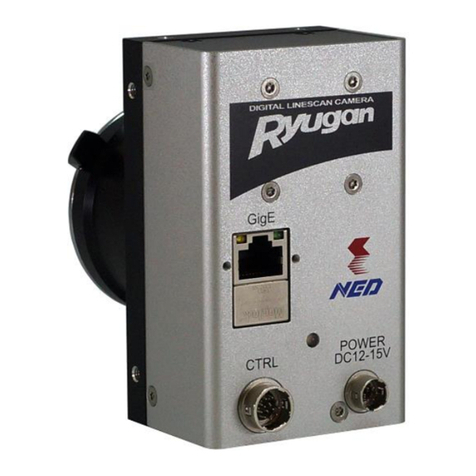
NED
NED RMSL6K17GE User manual

NED
NED XCM40170DLMT2CXP User manual
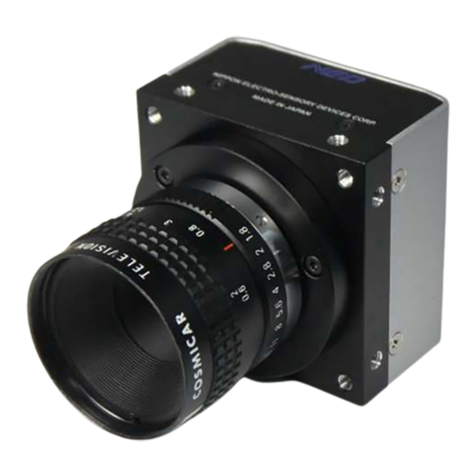
NED
NED XCM2085DLCT3 User manual
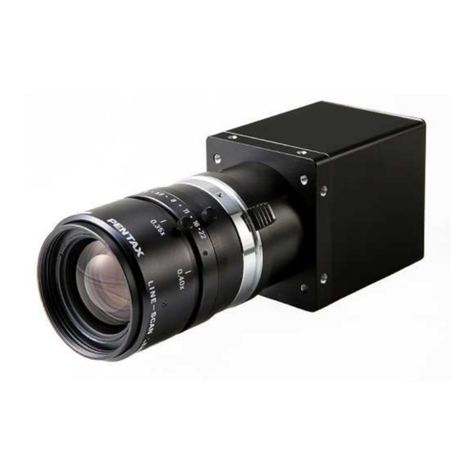
NED
NED SU2025GIG User manual

NED
NED CoaXpress XCM80160CXP User manual

NED
NED XCM4040DLMT4 User manual
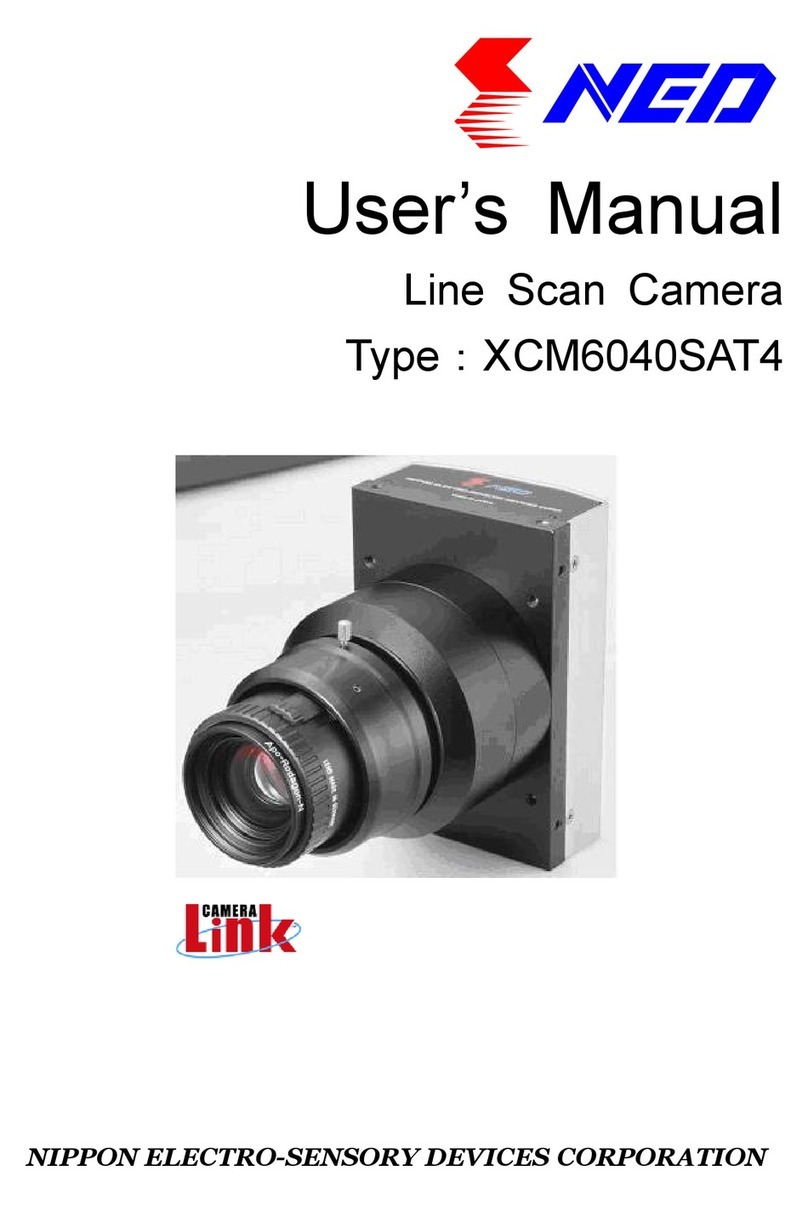
NED
NED XCM6040SAT4 User manual
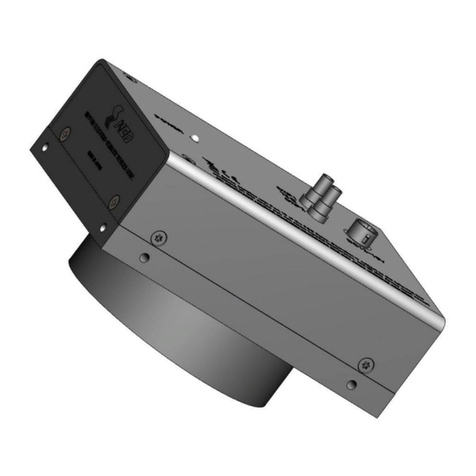
NED
NED RMSL8K76CP User manual

NED
NED RMSL4K100CP User manual
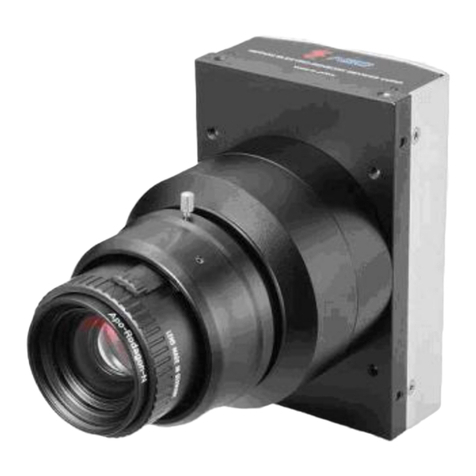
NED
NED Camera Link XCM8040SAT4 User manual
